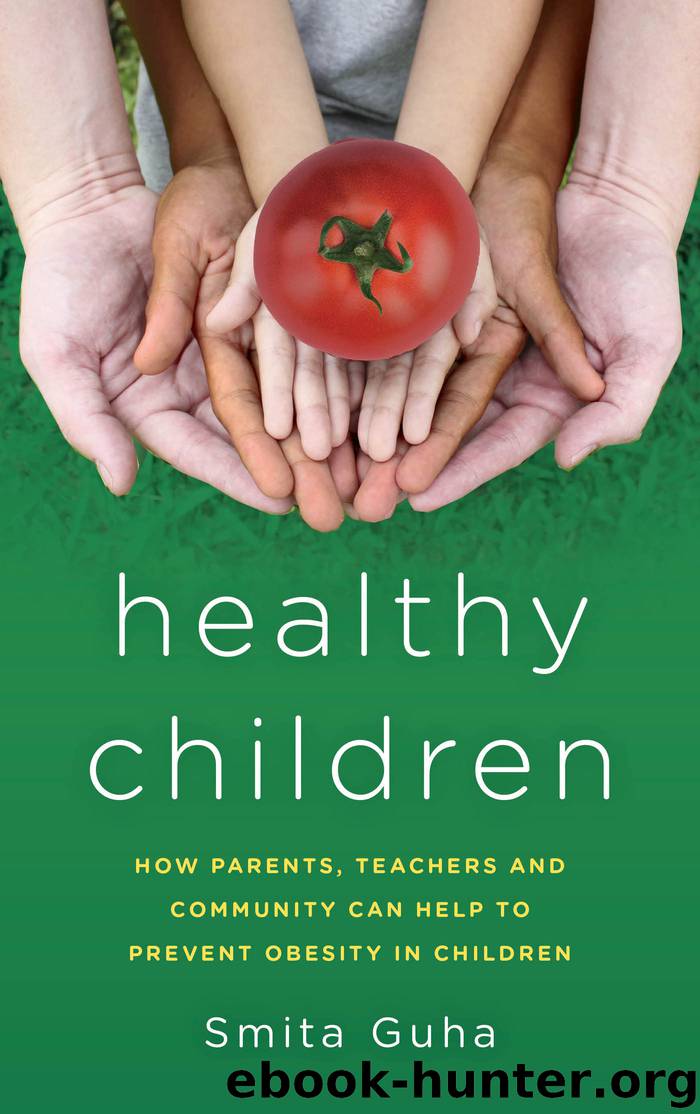Healthy Children by Smita Guha

Author:Smita Guha
Language: eng
Format: epub
Tags: undefined
Publisher: Rowman & Littlefield Publishers
Published: 2012-05-12T04:00:00+00:00
There are many positive ways that parents can educate children about making healthy choices. Strategies to incorporate healthy eating at home can be found in the many resources available to parents. For example, KidsHealth’s online article “Healthy Eating” suggests regular family meals, serving a variety of healthy food and snacks, acting as a role model, avoiding battles over food, and involving kids in the process. These tips apply to any household, as they are simple and manageable for the families who have busy lifestyles (Gavin, 2014).
Additionally, parents can educate themselves on healthy food choices and the economical options available to provide children with nutritious food. From the perspective of a school nurse, parents are to be held accountable because they often provide children with food and snacks that only exacerbate the problem.
The environmental factors that play a role in food selection, such as socioeconomic status, can negatively affect a child’s perception of healthy eating. Families buy the less expensive and less nutritious food because it is what they can afford. However, families need to be made aware that there are healthy food choices they can make with the same monetary value.
While parent(s) are a child’s primary educator, nutritional education should not end in the home. Educating children on healthy lifestyle choices is an essential aspect of their intellectual and physical development. Teachers, school nurses, and coaches have a responsibility to teach children about the consequences of their choices in foods and behaviors.
In the wake of the obesity epidemic, there is evidence of nutritional education efforts in schools. For example, the MyPlate initiative funded by the US Department of Agriculture is a program that is aimed at the current school-age population through the use of technology. The program’s platform, ChooseMyPlate (https://choosemyplate.gov), is a website for children to access and learn about how to choose healthy meals in an interactive way.
As stated on the website, MyPlate provides practical information to help the population “build healthier diets with resources and tools for dietary assessment, nutrition education, and other user-friendly nutritional information.” In relation to the obesity epidemic, MyPlate “empower[s] people to make healthier food choices for themselves, their families, and their children” (US Department of Agriculture).
Research suggests that schools can play a key role in the prevention of obesity through the implementation of strategies that promote health. To provide the necessary support, schools should first develop and introduce nutritional lessons and programs within the school curriculum. Emphasis on the importance of balanced and healthy nutrition should be incorporated as a separate subject, but also through other subjects such as science, chemistry, mathematics, and English.
A variety of nutrition books that teachers can base their lesson on are available. Educators can include these in their curriculum lesson plans connected with health and nutrition, and can also provide books to children’s families to read in order to adopt healthy habits in the home environment.
Another measure that schools have been required to adopt within the United States is the banning of junk food within schools. The US Department of Agriculture has issued new rules toward combating obesity.
Download
This site does not store any files on its server. We only index and link to content provided by other sites. Please contact the content providers to delete copyright contents if any and email us, we'll remove relevant links or contents immediately.
The Art of Coaching Workbook by Elena Aguilar(50127)
Trainspotting by Irvine Welsh(21048)
Twilight of the Idols With the Antichrist and Ecce Homo by Friedrich Nietzsche(18309)
Fangirl by Rainbow Rowell(8806)
Periodization Training for Sports by Tudor Bompa(7934)
Change Your Questions, Change Your Life by Marilee Adams(7388)
This Is How You Lose Her by Junot Diaz(6461)
Asking the Right Questions: A Guide to Critical Thinking by M. Neil Browne & Stuart M. Keeley(5364)
Grit by Angela Duckworth(5303)
Red Sparrow by Jason Matthews(5203)
Paper Towns by Green John(4811)
Room 212 by Kate Stewart(4743)
Ken Follett - World without end by Ken Follett(4452)
The Sports Rules Book by Human Kinetics(4084)
Housekeeping by Marilynne Robinson(4071)
Double Down (Diary of a Wimpy Kid Book 11) by Jeff Kinney(3937)
Papillon (English) by Henri Charrière(3923)
The Motorcycle Diaries by Ernesto Che Guevara(3794)
Exercise Technique Manual for Resistance Training by National Strength & Conditioning Association(3790)
